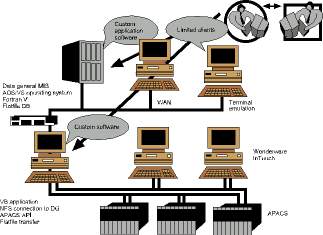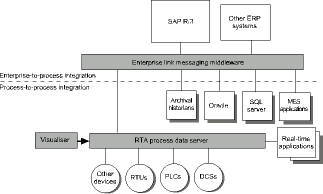
Iscor, a South African resources company, produces and markets long and flat steelwork products, as well as coal, iron ore, base metals and industrial minerals. Iscor Steel is the largest steel producer on the African continent, producing 5,6 million metric tons of crude steel per year. One of Iscor’s Strategic Business Units (SBU), Iscor’s Flat Steel Products, at the Vanderbijlpark Works in South Africa, accounts for 70% of Iscor’s total steel volume. This large steel facility supplies ~60% of its products to the local sub-Saharan Africa market, and ~40% to international markets spanning five continents.
At the Vanderbijlpark Steel plant, two sinter plants form part of its iron-making division. Each plant, A & B, carries out the production of sinter, a raw material supplied to downstream blast furnaces. The sinter plant upgrade is the focus of this case study. Since the mid-'80s, Iscor relied predominantly on expensive, custom-built applications to control the sinter plants. The problem with this infrastructure was that various kinds of data - blast furnace temperatures, pressure, mass of sinter and plant motor status - could not be accessed easily across networks. As a result, management was unable to view crucial information at timely intervals, due to missing or slow data transfer. The legacy system in place at the sinter plant, a proprietary legacy operating system, was not Y2K-compliant.

Old system
A complex, multilevel pyramid was in place to support the entire system at the sinter plant. At the base level, sensory and field devices picked up measurements and transferred them to the control system in place. This control system is the Moore APACS+ Distributed Control System (DCS) supplied by Iscor's channel partner, Moore Process Automation.
The interface for the DCS was the Wonderware InTouch scada Graphical User Interface. InTouch ran under the Windows NT operating system, with four Human Machine Interfaces (HMIs) available to control the plant. Data from the DCS was passed through an MBI card to an Intel 486 PC, which acted as a gateway to connect the bottom level with the top.
Applications on the gateway, written in Visual Basic 3.0, accessed data from the DCS and created flat files. The flat files were transferred every minute and hour via the Iscor WAN based on its corresponding file type, to the client server, a legacy management information system. The legacy system stored the data in a flat file database. This architecture caused several problems for Iscor management. The custom-built legacy system was old - and not Y2K compliant.

Managing this unreliable MIS incurred high maintenance costs. Furthermore, the flat files could not be accessed using standard Microsoft tools, making the system 'user-unfriendly.' Interaction with the legacy system was client-limited - and time synchronisation on the legacy system was not possible.
The human machine interfaces had poor trending capabilities due to the amount of workload. The network cards on the gateway computer were unable to isolate abnormal network traffic experienced on the WAN. As a result, the gateway would lock up, and data fed through to it would subsequently be lost - a bottleneck causing frustration for management. The custom software in place at the plant posed too many compatibility problems, incurred high costs, and needed experts to maintain it. The challenge was to upgrade the Manufacturing Execution System (MES), or the middle layer of the infrastructure, at the sinter plants.
The team identified four crucial components that would be needed for the new system. First, the legacy system had to be replaced by a new database server that was Y2K-compliant. Second, the gateway computer, an Intel 486 PC, needed to be replaced with standard communication objects to better transfer data across the plant. Third, the MES needed a new application server so clients could access information. Fourth, a realtime historian was needed to facilitate historical trending over the network as opposed to the proprietary control network. These issues prompted employees from various engineering departments to form a project team to further investigate the problems at hand, and concurrently, modernise the sinter plant system to current leading technology standards.
It was decided that the MES needed to be upgraded, using leading edge technology across the plant. That way, the easy distribution of data throughout the enterprise, and easy management accessibility would be realised. The key to making Iscor more plant centric was to implement Verano's (formerly Hewlett-Packard's) Enterprise Link.

New system
Given the problems at the sinter plants, the project team recommended that Iscor use standard templates across the enterprise. Packaged solutions by Microsoft products, such as Excel, MSQuery and Internet Explorer were used to enable the team to access data across the networks. Wonderware InSQL Server was implemented to replace the gateway computer and to sample and store the realtime data from the DCS. InSQL was chosen due to its trending capabilities, and its ability to offload the work of the man machine interfaces. Also, the realtime and summary data archived in InSQL could be accessed using SQL.
The management team needed to be able to monitor data more quickly - at one-minute resolutions. The InSQL Server had archived 3000 tags at one minute and hourly intervals. Enterprise Link, Verano's middleware automation integration software tool, was deployed to move data from the Wonderware INSQL realtime database to a MSSQL database for long-term archive purposes. Matrikon Systems, tasked by Moore Products, developed the interface that would allow Enterprise Link to communicate with seven production lines running Wonderware InSQL server.
Enterprise Link was chosen as the ideal plant-centric solution for several reasons. First, it was very easy to configure Enterprise Link to the production unit. Enterprise Link's configuration ease enabled users to map tables on the source server database to tables on the destination database. Second, Enterprise Link features excellent spooling capabilities, making it more robust when compared to other middleware tools.
During communication failures due to network traffic, Enterprise Link ensured data availability by archiving en-route messages. Further, when message data does become available for management, the most recent and current data is transmitted first. Third, Enterprise Link's trigger mechanisms helped to transmit data at crucial times. Fourth, data could be monitored from anywhere on the LAN via the Internet.
Resulting benefit
With the help of Enterprise Link, Iscor can effectively integrate plant floor data with its plant-centric management information system, providing management user-friendly access to meaningful information, whenever needed. Iscor can now access realtime, readily available data, maximising its production of sinter while minimising its costs.
Enterprise Link has permitted the integration of information both vertically (within the enterprise) as well as horizontally - between each plant and between the applications (accessing shared information). Realtime data can now be transferred quickly and thoroughly throughout the enterprise, using standard templates, significantly reducing time and maintenance costs.
With browser technology available to the clients, 'point and click' access enables easy data management. Iscor management can integrate strategically with its ERP backbone, as Enterprise Link is also certified by SAP as interface middleware.
According to John Bordalo, Iscor senior engineer, at the Iscor Vanderbijlpark Works, "Enterprise Link is the ideal two-way communication 'gateway' between InSQL Server and the management information system. The combination of Enterprise Link and InSQL Server has provided an amicable solution for the problems experienced in the past."
Future expansion
In early 2001, Iscor entered its final phase of corporate restructuring and re-engineering, aimed at maximising shareholder value. The company is now proceeding to integrate plant systems with SAP/R3.
Eric Hore, Moore Process Controls
011 466 1673
| Tel: | +27 11 466 1673/9 |
| Email: | [email protected] |
| www: | www.moore.co.za |
| Articles: | More information and articles about Moore Process Controls |

© Technews Publishing (Pty) Ltd | All Rights Reserved